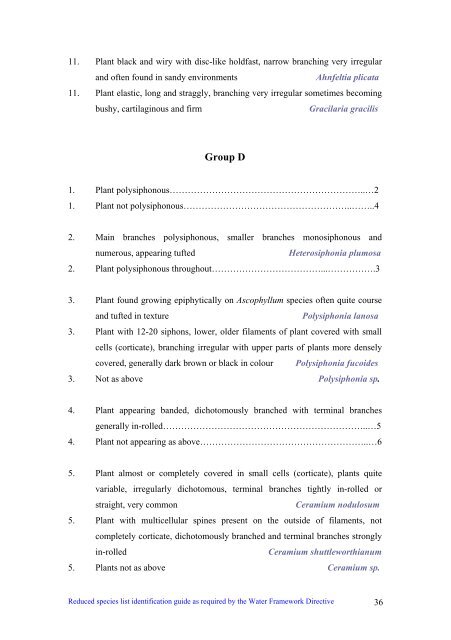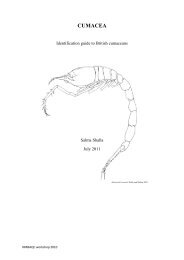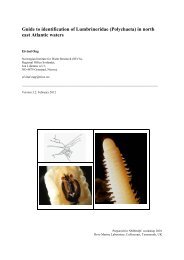s A Field Guide to the British Seaweeds - NMBAQC
s A Field Guide to the British Seaweeds - NMBAQC
s A Field Guide to the British Seaweeds - NMBAQC
You also want an ePaper? Increase the reach of your titles
YUMPU automatically turns print PDFs into web optimized ePapers that Google loves.
11. Plant black and wiry with disc-like holdfast, narrow branching very irregular<br />
and often found in sandy environments Ahnfeltia plicata<br />
11. Plant elastic, long and straggly, branching very irregular sometimes becoming<br />
bushy, cartilaginous and firm Gracilaria gracilis<br />
Group D<br />
1. Plant polysiphonous………………………………………………………..…2<br />
1. Plant not polysiphonous………………………………………………..……..4<br />
2. Main branches polysiphonous, smaller branches monosiphonous and<br />
numerous, appearing tufted Heterosiphonia plumosa<br />
2. Plant polysiphonous throughout………………………………...…………….3<br />
3. Plant found growing epiphytically on Ascophyllum species often quite course<br />
and tufted in texture Polysiphonia lanosa<br />
3. Plant with 12-20 siphons, lower, older filaments of plant covered with small<br />
cells (corticate), branching irregular with upper parts of plants more densely<br />
covered, generally dark brown or black in colour Polysiphonia fucoides<br />
3. Not as above Polysiphonia sp.<br />
4. Plant appearing banded, dicho<strong>to</strong>mously branched with terminal branches<br />
generally in-rolled…………………………………………………………..…5<br />
4. Plant not appearing as above………………………………………………..…6<br />
5. Plant almost or completely covered in small cells (corticate), plants quite<br />
variable, irregularly dicho<strong>to</strong>mous, terminal branches tightly in-rolled or<br />
straight, very common Ceramium nodulosum<br />
5. Plant with multicellular spines present on <strong>the</strong> outside of filaments, not<br />
completely corticate, dicho<strong>to</strong>mously branched and terminal branches strongly<br />
in-rolled Ceramium shuttleworthianum<br />
5. Plants not as above Ceramium sp.<br />
Reduced species list identification guide as required by <strong>the</strong> Water Framework Directive 36




